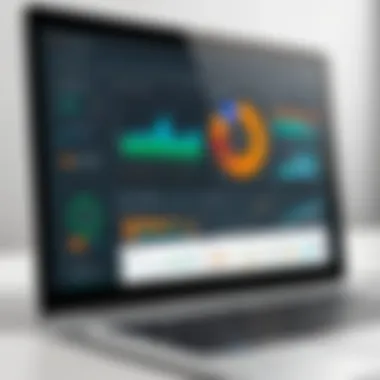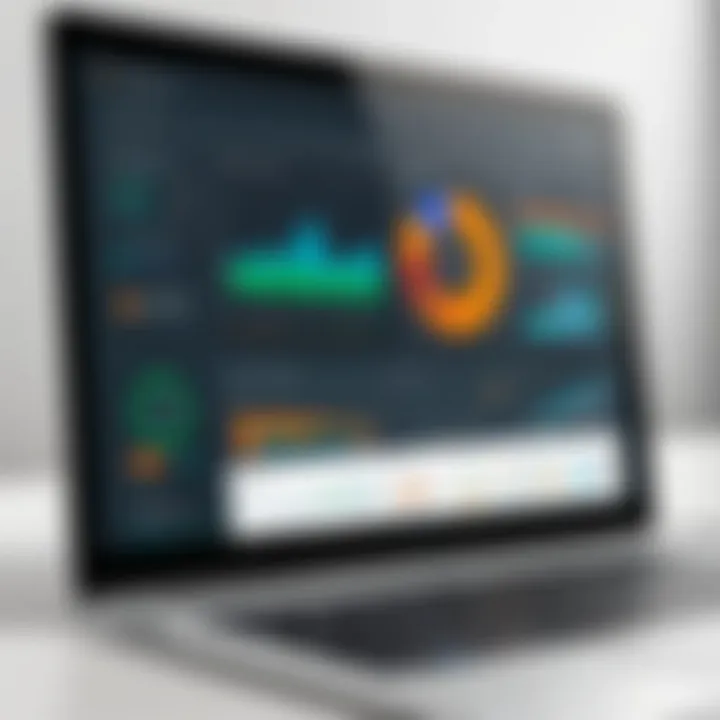Ad Hoc Reports in Tableau: A Comprehensive Guide


Intro
In today’s data-driven environment, the ability to create ad hoc reports is essential for informed decision-making. Tableau, as a robust data visualization tool, offers businesses the capability to generate customized reports swiftly. This guide aims to explore the intricacies of ad hoc reporting within Tableau, examining its features, significance, and best practices. By understanding these elements, organizations can leverage Tableau's full potential and enhance their reporting processes.
Key Features
Overview of Features
Ad hoc reporting in Tableau equips users with the ability to generate timely reports tailored to specific queries. Unlike standard reporting, which often follows structured inputs, ad hoc reports allow for flexibility and spontaneity. Key features include:
- Customizable Dashboards: Users can design dashboards that meet their unique reporting needs by dragging and dropping elements.
- Real-Time Data Analysis: Tableau connects with multiple data sources, providing live updates for immediate insights.
- Interactive Visualizations: Users can engage with data through drill-downs and filters, facilitating a deeper understanding of metrics.
These features are crucial for professionals who must respond rapidly to market changes or internal queries.
Unique Selling Propositions
Tableau's unique selling propositions enhance its utility for ad hoc reporting:
- User-Friendly Interface: The drag-and-drop functionality simplifies complex data interactions.
- Integration with Existing Tools: Seamless connectivity with other platforms facilitates a comprehensive view of business data.
- Collaboration Capabilities: Users can share reports easily with stakeholders, fostering a collaborative environment.
Pricing Models
Different Pricing Tiers
Tableau offers various pricing options to accommodate different organizational sizes and requirements. The pricing structures include:
- Tableau Public: Free access to a limited version, suitable for individuals and small projects.
- Tableau Creator: Designed for advanced analytics, typically at a higher cost, it includes tools necessary for creating detailed reports.
- Tableau Explorer: For users who need to analyze data regularly and share insights with teams but require fewer capabilities than Creator.
- Tableau Viewer: A budget-friendly option for users who need to view reports without the ability to create or modify them.
ROI and Cost-Benefit Analysis
The return on investment for utilizing Tableau can be substantial. Companies often see improved decision-making processes and greater data visibility. When choosing a pricing tier, organizations should consider the following:
- Increased Efficiency: Automation of reports saves time and resources.
- Data-Driven Decisions: Enhanced insights lead to better strategic choices.
- Scalability: As business needs evolve, Tableau offers the flexibility to adapt.
By evaluating these aspects, businesses can better understand the financial justification for implementing Tableau into their operations.
"Ad hoc reporting empowers organizations by providing the right information at the right time, influencing critical business decisions."
Understanding these crucial components will enable users to not only utilize Tableau effectively, but also to align its capabilities with their overall reporting strategies.
Preface to Ad Hoc Reporting
Ad hoc reporting is essential in the field of data analysis and business intelligence. It empowers organizations to generate reports tailored to specific needs or inquiries without requiring pre-set formats. This flexibility allows for deeper insights into data, as users can explore and visualize information in a manner that aligns closely with their immediate objectives. The ability to create on-the-fly reports significantly enhances decision-making processes, enabling stakeholders to react swiftly to changes in data.
Definition and Importance
Ad hoc reports are unplanned and spontaneous reports created by users as needed. Unlike standard reports that adhere to a consistent format, ad hoc reports allow for customized querying and analysis. This is vital for organizations that need to respond quickly to market trends or internal changes. The importance of ad hoc reporting lies in its real-time capacity to unveil insights that traditional reporting might miss.
The timely generation of ad hoc reports fosters agility in decision-making. They provide a way to test hypotheses, analyze new questions, and explore data from different perspectives. In a rapidly changing business environment, the ability to harness fresh data insights can provide a competitive advantage. This approach also promotes a culture of data-driven decision-making, where personnel at varying levels within an organization can derive actionable insights from data without being dependent on data teams.
Why Choose Tableau for Ad Hoc Reporting
Tableau is a leading data visualization tool that excels in handling ad hoc reporting tasks. Its user-friendly interface allows users, even those with limited technical ability, to create visual reports effectively. With Tableau, users can connect to various data sources, manipulate data, and visualize insights seamlessly.
Some key benefits of using Tableau for ad hoc reporting include:
- Interactive Visualizations: Tableau offers rich, interactive data visualizations that help users explore data dynamically.
- Ease of Use: The drag-and-drop functionality makes it easy for non-technical users to create complex reports.
- Data Connectivity: Tableau supports a wide range of data connectors, allowing users to pull data from multiple sources effortlessly, including relational databases and cloud services.
- Real-Time Data Insights: Users can refresh data sources to obtain up-to-the-minute analysis, facilitating quick decision-making under changing circumstances.


"Ad hoc reporting turns data into timely insights, fostering a proactive approach to business intelligence."
Overall, the integration of Tableau in the ad hoc reporting landscape enhances the ability for organizations to be flexible and responsive to both internal inquiries and external market conditions.
Understanding Tableau's Framework
Understanding Tableau's framework is essential for effectively using ad hoc reporting features. It is not just about creating visualizations; it also involves knowing the structure and functionality that Tableau provides. This knowledge enables users to harness the full capabilities of Tableau, transforming raw data into insightful reports. Companies often need to make real-time decisions, and Tableau's flexible architecture supports this need. Therefore, grasping the key components of Tableau is crucial.
Overview of Tableau's Architecture
Tableau is structured around a client-server model. At its core, you have the Tableau Desktop, where users create and design reports. This application connects to various types of data sources, ranging from simple spreadsheets to complex databases like SQL Server and Oracle. The Tableau Server or Tableau Online is where these reports are published and accessed by various stakeholders.
The architecture consists of layers that interact, enabling seamless data analysis:
- Data Layer: This includes all the data connections and sources used within Tableau. Understanding this allows users to make informed decisions about data integrity and source selection.
- Processing Layer: Here, Tableau processes the data requested by users, applying any transformations or aggregations. This layer's performance is crucial for larger datasets.
- Presentation Layer: This is where the data visualizations are crafted. It is the final output that users and decision-makers interact with, making it important for the visual aspects to be clear and effective.
This structure supports various functionalities, such as data blending, calculations, and advanced analytics.
Data Connection Methods
Tableau offers multiple methods to connect data. These options provide flexibility for users, allowing them to choose the best way to import their data. Here are the primary connection methods available in Tableau:
- Live Connection: This method allows Tableau to connect directly to a data source in real time. It is best for up-to-date data, useful for operational reporting.
- Extract Connection: This creates a snapshot of the data stored within Tableau. It is beneficial for performance, allowing faster interactions, especially with large datasets. Users can refresh this data as needed.
- Blend Connections: This technique allows users to combine data from multiple sources without needing to merge them before analysis. It helps in comparative studies where you need insights from different origins.
Importantly, choosing the right connection method affects performance and the accuracy of insights generated.
In summary, understanding Tableau's framework is fundamental for anyone looking to utilize ad hoc reporting to its fullest potential. It lays the groundwork for effective report creation, enabling clarity in data handling and visualization chapters.
Creating an Ad Hoc Report in Tableau
Creating an ad hoc report in Tableau is a pivotal aspect of leveraging this tool for effective data analysis. This process allows users to generate spontaneous reports based on real-time data without being bound by pre-existing templates. The flexibility inherent in Tableau aids businesses in making informed decisions quickly, adapting to shifting priorities or new insights with ease. Understanding how to create these reports not only enhances the usability of Tableau but also empowers users to extract valuable insights from data.
Setting Up Your Data Sources
The initial step in crafting an ad hoc report involves connecting to appropriate data sources. Tableau offers a rich variety of connection options, whether pulling information from local files, databases, or online data sources. This adaptability is crucial. For instance, connecting directly to a SQL database can enable real-time data analysis, ensuring that the reports reflect the most current information available.
Here are some points to consider while setting up your data sources:
- Data integrity: Ensure that the data being connected is accurate and up to date.
- Connection types: Understand the differences between live connections and extracted data. Live connections provide real-time insights while extracts offer speed advantages.
- Data blending: Sometimes, it may be necessary to combine data from multiple sources. Tableau's data blending capabilities help in merging disparate datasets effectively.
Designing the Report Layout
Once data sources are established, attention shifts to designing the report layout. A well-structured layout enhances clarity and improves the overall user experience. In Tableau, the drag-and-drop interface allows users to easily rearrange elements to find the most effective visualization.
When considering report layout design, keep these principles in mind:
- Hierarchy: Arrange visuals and data fields in an order that elevates important insights.
- White space: Use space effectively to avoid clutter. Overly packed visualizations can confuse the user.
- Consistency: Maintain a consistent design style across visuals, using similar fonts, colors, and chart types.
Incorporating Filters and Parameters
Incorporating filters and parameters is essential to enhance the interactivity of ad hoc reports. Filters allow users to narrow down data views based on specific criteria, enabling focused analysis. Parameters, on the other hand, provide a means to dynamically control variables in the visualization.
Consider these aspects when incorporating filters and parameters:
- User control: Transparency in what data is being viewed can allow users to refine their queries easily.
- Performance: Be cautious about the number of filters applied, as excessive filtering may slow down the report's performance.
- Parameter controls: Implement parameters that allow users to interact with the report on a higher level, such as choosing dimensions or measures dynamically.
"Ad hoc reporting in Tableau is about agility and responsiveness in analysis. Users can swiftly generate insights tailored to immediate needs, ensuring that decisions aren't based on outdated data."
Enhanced Visualization Techniques


Enhanced visualization techniques are crucial for making data comprehensible and actionable. In the context of Tableau, they play a key role in transforming raw data into insightful and visually appealing reports. These techniques help present complex information clearly, aiding analysis and decision-making for users. The right visual representation can reveal trends, patterns, and outliers that may not be apparent from raw datasets alone.
Using these techniques effectively requires understanding the audience’s needs and the story the data seeks to tell. Proper visualization can not only simplify complex information but also engage viewers, prompting deeper insights. Considerations must include choosing appropriate chart types and applying design principles, such as color usage and layout.
"Data is a precious thing and will last longer than the systems themselves." — Tim Berners-Lee
Choosing the Right Chart Types
Choosing the right chart types is fundamental in data visualization. Different chart types convey distinct information and cater to various analytics purposes. Here are common types and their applications:
- Bar Charts: Useful for comparing discrete categories. They effectively show differences in magnitude across different groups.
- Line Graphs: Best for displaying trends over time. They highlight changes in data at different intervals, which is vital for time-series analysis.
- Pie Charts: While they show proportions, they can be misleading. Use sparingly and mainly when you need to display parts of a whole.
- Scatter Plots: Ideal for showing relationships between two numeric variables. They help visualize correlations and can identify outliers.
Each type has its strengths. Picking a chart type involves understanding the data and the message trying to be communicated. A poorly chosen chart can obscure meaning rather than clarify it, potentially leading to misconceptions.
Using Color and Design Principles
Color and design principles significantly affect the impact of visualizations. Colors can guide attention and convey meaning, but improper use can confuse or mislead audiences. Here are some best practices:
- Consistency: Use a consistent color palette throughout reports to maintain a unified visual language.
- Contrast: Ensure sufficient contrast between colors to enhance readability and visibility.
- Simplicity: Avoid clutter in visuals. A clean design allows the audience to focus on key insights instead of being distracted.
- Color Blindness Considerations: It’s essential to choose color schemes that remain effective for color-blind individuals.
Applying these principles can enhance the clarity and appeal of reports, making data more accessible. Ultimately, the goal is to create visuals that not only inform but also engage the audience effectively.
Advanced Features of Tableau for Ad Hoc Reporting
In the landscape of data visualization and reporting, Tableau stands out due to its advanced features tailored for ad hoc reporting. This capability allows users to analyze data without significant prior preparation or extensive technical knowledge. Users can quickly derive insights and make decisions in real time. Understanding these features is crucial for anyone looking to leverage Tableau for their organization's reporting needs.
Calculated Fields and Aggregations
Calculated fields are a powerful feature in Tableau, enabling users to create new data from existing datasets. This is particularly useful for businesses that require specific metrics that are not readily available within standard reports. For example, a business may need to analyze profit margins based on sales and costs. By creating a calculated field, users can define the formula needed to derive this value, enhancing customization within reports.
Aggregations are equally important. They allow users to summarize data effectively and gain insights at various levels. Whether one seeks to find sums, averages, or counts, utilizing Tableau’s aggregation functions can streamline the analysis.
The ability to create calculated fields and use aggregations in real-time permits users to have an agile approach towards ad hoc reporting. This flexibility is invaluable in fast-paced environments where decisions need to be made swiftly and based on real-time data.
Dashboard Creation and Best Practices
Dashboards in Tableau serve as the visual interface where users can combine multiple visualizations into a single canvas. A well-crafted dashboard can provide a comprehensive view of crucial metrics, facilitating quicker and informed decision-making. It is essential, however, to adhere to certain best practices to achieve effectiveness.
- Clarity and Focus: The dashboard should highlight the most pertinent data. Too much information can overwhelm users and hinder insights.
- Consistent Layout: Utilize grids or consistent formatting to make the dashboard user-friendly. This includes standardizing font sizes and colors.
- Interactivity: Leverage Tableau’s interactive features, such as filters and highlight actions. This enables users to engage with the data more dynamically.
- Testing Before Deployment: Carry out iterative tests on dashboards. Gather feedback from potential users to ensure functionality aligns with real-world expectations.
Implementing these practices can significantly enhance the utility of dashboards in ad hoc reporting, ultimately leading to better data-driven decision-making.
"A good dashboard not only informs but also invites users to explore further."
In summary, the advanced features of Tableau, such as calculated fields, aggregations, and effective dashboard creation, are essential for optimizing ad hoc reporting. Emphasizing these elements ensures that organizations can harness their data's full potential, thus enabling agile responses to ever-evolving business needs.
Challenges in Ad Hoc Reporting
Ad hoc reporting serves essential functions in data analysis and decision-making processes. Yet, this method is not without its challenges. Identifying and understanding these challenges can help organizations implement better strategies. The purpose of this section is to illuminate the concerns that arise during ad hoc reporting, focusing on vital aspects such as data quality and user training.
Data Quality and Integrity Issues
One of the primary concerns in ad hoc reporting is data quality. Accurate data is the backbone of reliable reports. If the data is flawed, the conclusions drawn from it can mislead decision-makers. Common data quality issues include missing values, duplication, and inconsistencies across different sources. Organizations must prioritize data integrity to ensure robust reporting.
Key considerations include:
- Data Source Reliability: Assessing the trustworthiness of the data sources is crucial. Relying on accurate, real-time data minimizes errors.
- Data Validation Processes: Implementing validation checks can detect anomalies before they affect the reporting phase.
- Stakeholder Contribution: Engaging stakeholders to understand their data needs and concerns ensures that data collected is relevant and of high quality.


The impact of poor data quality can be profound. It can lead to a lack of confidence in reports, which may subsequently diminish their utility.
"The effectiveness of an ad hoc report relies significantly on the reliability of the underlying data."
User Training and Adoption Challenges
Another significant challenge in ad hoc reporting is user training. Many users may not possess the necessary skills to navigate Tableau or perform ad hoc analysis effectively. Without adequate training, users may struggle to utilize the software’s capabilities, resulting in underutilization of the tool.
Important elements to consider include:
- Understanding the Tool: Users must grasp the nuances of Tableau, including its data connection methods and report design features.
- Training Programs: Structured training programs can foster better understanding and comfort with the tool. Ongoing support also aids in user confidence.
- Encouraging Engagement: Motivate users to engage actively with the data. Highlighting real-world applications can boost motivation.
Fostering a culture of learning and adaptability can positively influence the adoption of ad hoc reporting tools within organizations. When users feel supported, they are more likely to see the value in their data and utilize it effectively.
Best Practices for Effective Ad Hoc Reporting
Ad hoc reporting is a powerful tool, yet its effectiveness largely depends on following best practices. This section details the significance of structured approaches in establishing, testing, documenting, and training. These practices ensure clarity, enhance user experience, and maintain data integrity, which is essential for achieving insightful results. By implementing these guidelines, organizations can maximize their investment in Tableau.
Establishing Clear Objectives
Setting clear objectives is crucial for any ad hoc report. When users know the specific goals of their analysis, they can tailor their queries to meet those needs effectively. Failing to outline these objectives can lead to irrelevant data being processed, resulting in wasted time and resources.
- Define Your Purpose: Before generating a report, users must ask what insights they seek or decisions they hope to support. Are they exploring trends, detecting anomalies, or confirming assumptions?
- Target Audience Consideration: Knowing who will use the report can inform its complexity and design. Different stakeholders might require varying depths of information.
- Measurement Standards: Establish metrics that will indicate success or failure. This helps in evaluating the report’s effectiveness based on whether it meets its stated goals.
Iterative Testing and Feedback
Iterative testing and soliciting feedback are vital to refine ad hoc reports. This process cultivates an environment of continuous improvement and adaptation.
- Prototyping: Begin with a draft report. Share it with a selective group of users for initial impressions and critiques. Their insights can guide further refinements.
- Test Different Scenarios: Evaluating reports under varying conditions can highlight limitations or areas needing adjustment. Different datasets or filters may produce different outcomes that are worth examining.
- Incorporate User Input: Creating a feedback loop can facilitate greater user engagement. Regular updates based on user experience can help tailor reports to evolving needs.
Documentation and Training Resources
Strong documentation and comprehensive training resources bolster understanding and competence in using Tableau for ad hoc reporting. They serve as guides for new users and help integrate good practices broadly across the organization.
- Create User Manuals: Document clear instructions on how to access and utilize reports. Include screenshots for visual guidance whenever possible. Users have different learning preferences, so manuals must cater to various styles.
- Hold Training Sessions: Regularly scheduled training can help users familiarize themselves with Tableau’s capabilities. Hands-on workshops promote practical understanding.
- Utilize Online Resources: Direct users to additional resources like tutorials or forums. Websites such as Wikipedia, Britannica, and Reddit offer valuable information about data visualization best practices and problem-solving methods.
"Clear objectives drive the successful implementation of ad hoc reports. Testing and documentation enhance usability."
By executing these best practices, organizations will foster more effective ad hoc reporting using Tableau, ultimately leading to better-informed decisions.
The Future of Ad Hoc Reporting
The landscape of ad hoc reporting is changing rapidly, influenced by technological advancements and the evolving needs of businesses. As organizations strive for agility and responsiveness, ad hoc reporting plays a vital role in data-driven decision-making. In this section, we focus on the future of ad hoc reporting, including emerging trends and the integration of innovative technologies.
Emerging Trends in Business Intelligence
The world of business intelligence is witnessing several significant trends that will shape the future of ad hoc reporting. First, there is an increasing demand for real-time data analysis. Accessing live data allows organizations to make informed decisions quickly, adapting to market changes more effectively.
Additionally, self-service analytics is becoming a norm. Users, regardless of their technical skills, now seek tools that enable them to create reports independently. This democratization of data empowers business teams to generate insights without always relying on IT departments.
Furthermore, cross-platform and multi-device access to data is crucial. Users want the flexibility to analyze reports wherever they are, using any device. This trend enhances user engagement and fosters a culture of data literacy across organizations.
Other noteworthy trends include an increased focus on data governance, ensuring that the data used is accurate and secure. Organizations are implementing stricter guidelines to maintain data integrity.
Integration of AI and Machine Learning
Ad hoc reporting will greatly benefit from the integration of artificial intelligence (AI) and machine learning (ML). These technologies can automate complex data analysis tasks that usually require substantial human input. With AI, ad hoc reporting tools can provide predictive analytics, allowing users to identify trends and forecast outcomes based on historical data.
Machine learning algorithms can improve data accuracy and facilitate better data cleaning. The ability of these models to learn from data means they can progressively refine their outputs. Consequently, users can derive accurate insights swiftly.
Moreover, natural language processing (NLP) allows users to ask questions in plain language and receive meaningful reports without needing complex query languages. This approach removes barriers that often hinder non-technical users, making data interpretation more accessible than ever before.
In summary, the future of ad hoc reporting is bright. As technologies like AI and machine learning become more prevalent, organizations will experience enhanced analysis, greater agility, and deeper insights into their operations. The convergence of emerging trends and advanced technologies promises to reshape how businesses handle ad hoc reporting, fostering a more data-centric approach.
Organizations must adapt to these changes to remain competitive in the current market environment.















